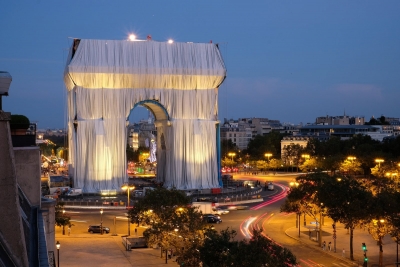
Arc de Triomphe in Paris, France was wrapped in lustrous fabric from September 18 to October 3, as part of a posthumous installation by Bulgarian-born artist Christo and French artist Jeanne-Claude. The monument was covered in 25.000 sq metres of silvery blue fabric and 3,000m of red rope, costing nearly 14 million pounds. Christo Javacheff and Jeanne-Claude were known for their larger-than-life installations where they wrapped many famous monuments and places. The temporary artwork was titled L’Arc de Triomphe, Wrapped and was completed on Christo’s request.
The project was initially slated for April 2020 but was delayed, first to accommodate the kestrel falcons who nested in the monument and then because of the COVID-19 pandemic. Work began in mid-July, and the full installation will be on view from September 18 to October 3. It’s fitting Christo and Jeanne-Claude’s first posthumous project is being staged in the City of Lights, where the pair met in the 1950s and where they staged their first “public intervention”: In 1962’s Wall of Oil Barrels – The Iron Curtain the pair blocked off a narrow street in the 6th arrondissement with 89 oil drums as a protest against the then-new Berlin Wall.
The first public building they wrapped was the Kunsthalle art museum in Bern, Switzerland, in 1968, followed in 1969 by the Chicago Museum of Contemporary Art. That same year Christo and Jeanne-Claude shrouded a 1.5-mile stretch of Sydney’s Little Bay in a million square feet of plastic fabric. In the decades that followed they draped Paris’ Pont Neuf bridge, the Reichstag building in Berlin, a section of Rome’s Aurelian Walls, King’s Beach in Newport, Rhode Island, and other locations.
The idea for covering the Arc de Triomphe predates all those works, though—Christo first sketched it out in 1961, when he lived nearby in a rundown apartment—but it wasn’t formally proposed until 2017, eight years after Jeanne-Claude’s death and three years before Christo’s.
Credit : Architectural Digest
Picture Credit : Google
Leave a Reply